#Lettuce Lake State Park
Text
Stupid beautiful walk for my stupid mental health | Lettuce Lake Park, Tampa, Florida, Hillsborough River, United States.
In sickness and in health
I often wonder if my husband knew how quickly those vows would be tested.
Beyond thankful for my partner
1 note
·
View note
Text
Fun Things to Do in Tampa FL and Nearby Areas
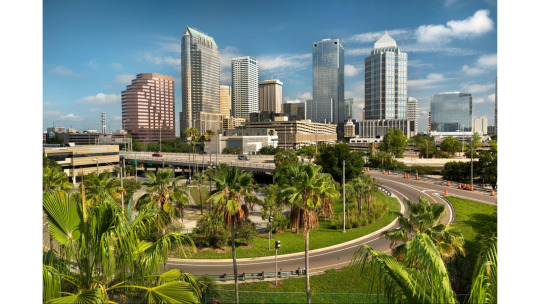
Whether you are visiting Tampa FL for the first time or you're a seasoned visitor, there are plenty of fun things to do in Tampa FL and nearby areas. For example, if you want to learn more about the history of the area, you can check out the Armature Works and the Ybor City. You can also check out the Florida Aquarium and the Tampa Zoo at Lowry Park.
Lettuce Lake Regional Park
Located on the Hillsborough River, Lettuce Lake Park in Tampa, FL is a secluded oasis for nature lovers. Known for its abundant wildlife, Lettuce Lake offers nature walks, kayaking and hiking.
The Lettuce Lake Regional Park has 240 acres of wooded picnic areas and playgrounds, as well as an observation tower. The park is also a great place to learn about nature. Lettuce Lake Regional Park features a modern interpretive center with educational exhibits. There are also ranger-led tours.
The park features a 3,500-foot boardwalk along the Hillsborough River. The boardwalk is a great place to see wildlife, including alligators. There are also canoe and kayak rentals available.
Tampa Zoo at Lowry Park
Located in Tampa, Florida, ZooTampa at Lowry Park is a 63-acre nonprofit zoo. It is one of the top zoos in the southeastern United States and is recognized by the State of Florida as a center for Florida biodiversity.
ZooTampa is committed to providing critical care for injured and threatened animals. Visitors have the chance to meet and interact with Aldabra tortoises, the second-largest land tortoise in the world. The zoo also offers educational opportunities to teach visitors about endangered species.
ZooTampa's African and Asian Domains feature safari-like attractions that explore the wonders of Africa and Asia. The Asian Domain features animals such as the Komodo dragon, babirusa, and Malayan tigers.
Tampa Riverwalk
Whether you're in Tampa for a quick weekend getaway or a week long family vacation, you'll find plenty of fun things to do in Tampa. Tampa is also home to some amazing animal attractions. You can see a wide variety of wildlife in the area, including a manatee sanctuary and a tidal river.
The Tampa Riverwalk is a 2.5-mile paved scenic trail that runs alongside the Hillsborough River. This walking path offers parks, public art, stores, and restaurants. The Tampa Museum of Art is located in a dazzling six-story cube building and is home to some great art. You can also enjoy some free art making activities on Saturdays.
Ybor City
Ybor City is a historic neighborhood in Tampa, Florida. It has a distinctive cultural legacy and has been named a National Historic Landmark District. It is one of the most celebrated neighborhoods in Florida and a popular destination for history buffs.
Ybor City is home to many restaurants, art galleries, and museums. It also has a unique cultural mix of languages, customs, and architecture. The district features cobbled streets, historic buildings, and old school architecture.
The city's historic architecture and Latin culture are reflected in its vibrant nightlife. In the 1990s, the district became a popular nightlife destination. The city is also home to several live music venues.
Armature Works
Located near the Hillsborough River, Armature Works is a great place for a relaxing lunch or dinner. The restaurant has plenty of seating both indoors and outdoors, as well as a number of dining options. The building also offers a rooftop bar, cooking classes and an entertainment workshop.
Another of the fun things to do in Tampa FL is the Glazer Children's Museum. This incredibly fun museum has an excellent collection of interactive exhibits and activities, which promote creativity and innovation. There are 150 hands-on activities to choose from.
Florida Aquarium
Whether you're looking for a good time, an educational experience, or both, there are many fun things to do in Tampa and the surrounding areas. Tampa has a large selection of museums, nightlife, and parks.
The Florida Aquarium is one of the most popular tourist attractions in Tampa. It's the largest aquatic museum in the state and contains more than 8,000 marine animals and aquatic plants. Visitors can interact with sharks, dolphins, and other animals in a number of exhibits. There are also interactive programs for children.
Urban Air Trampoline and Adventure Park
Large-scale indoor trampoline center hosting open jump, fitness classes, dodgeball & parties.Urban Air Trampoline and Adventure Park offers a number of fun things to do. There are many attractions to choose from, including a virtual reality experience, an obstacle course, bumper cars, a dodgeball arena, and an indoor coaster. This indoor park is the perfect place to spend an afternoon with the family.
Urban Air has something for everyone. There are several fun things to do for the little ones, and even older kids will be impressed. For those looking for a bit of competition, the park also offers a dodgeball arena and two types of bumper cars.
Urban Air is also home to the Apex Trampoline, which allows you to soar up and over the walls. You can also find bumper cars, the latest in trampoline technology, and an obstacle course. Urban Air Trampoline and Adventure Park is a good place to spend an afternoon, especially in the winter months.
Heritage Harbor Club House
Whether you enjoy golf, swimming, tennis, or even boating, Heritage Harbor Club House in Lutz, Florida is a great place to live. With a great location, you'll be close to the best shopping, restaurants, and health care. Whether you are looking for a single family home or a condominium, Heritage Harbour has a variety of options for you.

Residential locksmith
A good residential locksmith will be able to advise you on the best locking mechanisms for your particular property.
There are numerous locksmiths in the business, some specialize in commercial locking mechanisms while others are more adept at the residential end of things. Make sure to compare prices from several companies before making a final decision.
Using a locksmith in the home will not only save you time and trouble, but it will also keep your property safe. Some locksmiths will even perform maintenance on your locks.
Expert Locksmith Services llc
13542 N Florida Ave Suite # 211A, Tampa, FL 33613
(813) 592-8474
https://expertlocksmithservicesllc.com/
0 notes
Text
Selective Color Project--Lettuce Lake Florida
Selective Color Project–Lettuce Lake Florida
The latest addition to my Selective Color Project is this kayaker. Taken at Lettuce Lake Park in Tampa Florida. Edited using Photoshop layers.
To see other images and buy apparel or prints, please visit my commercial gallery.

View On WordPress
1 note
·
View note
Photo

Nature!
#lettuce lake park#tampa#fl#trees#nature#natural park#state park#florida#beautiful#peaceful#serene#quiet
2 notes
·
View notes
Photo

DID YOU KNOW THIS ABOUT ARIZONA? And those of us who have the distinct pleasure of living here ... now you all know why, at least in part, everyone is flocking here in droves ...
> 1. Arizona has 3,928 mountain peaks and summits, more mountains than any one of the other Mountain States (Colorado, Idaho, Montana, Nevada, New Mexico, Utah, and Wyoming).
> 2. All New England, plus the state of Pennsylvania would fit inside Arizona.
> 3. Arizona became the 48th state and last of the contiguous states on February 14, 1912.
> 4. Arizona's disparate climate can yield both the highest temperature across the nation and the lowest temperature across the nation in the same day.
> 5. There are more wilderness areas in Arizona than in the entire Midwest. Arizona alone has 90 wilderness areas, while the Midwest has 50.
> 6. Arizona has 26 peaks that are more than 10,000 feet in elevation.
> 7. Arizona has the largest contiguous stand of Ponderosa pines in the world stretching from near Flagstaff along the Mogollon Rim to the White Mountains region.
> 8. Yuma, Arizona is the country's highest producer of winter vegetables, especially lettuce.
> 9. Arizona is the 6th largest state in the nation, covering 113,909 square miles.
> 10. Out of all the states in the U.S., Arizona has the largest percentage of its land designated as Indian lands.
> 11. The Five C's of Arizona's economy are: Cattle, Copper, Citrus, Cotton, and Climate.
> 12. More copper is mined in Arizona than all the other states combined, and the Morenci Mine is the largest copper producer in all of North America.
> 13. Clark Gable and Carole Lombard, two of the most prominent movie stars of Hollywood's Golden Age, were married on March 18, 1939, in Kingman, Arizona.
> 14. Covering 18,608 sq. miles, Coconino County is the second largest county by land area in the 48 contiguous United States.(San Bernardino County in California is the largest)
> 15. The world's largest solar telescope is located at Kitt Peak National Observatory in Sells, Arizona..
> 16. Bisbee, Arizona is known as the Queen of the Copper Mines because during its mining heyday it produced nearly 25 percent of the world's copper and was the largest city in the Southwest between Saint Louis and San Francisco.
> 17. Billy the Kid killed his first man, Windy Cahill, in Bonita, Arizona.
> 18. Arizona grows enough cotton each year to make more than one pair of jeans for every person in the United States.
> 19. Famous labor leader and activist Cesar Chavez was born in Yuma.
> 20. In 1912, President William Howard Taft was ready to make Arizona a state on February 12, but it was Lincoln's birthday. The next day, the 13th, was considered bad luck so they waited until the following day. That' how Arizona became known as the Valentine State.
> 21. When England's famous London Bridge was replaced in the 1960s, the original was purchased, dismantled, shipped stone by stone and reconstructed in Lake Havasu City, Arizona, where it still stands today.
> 22. Mount Lemmon, Tucson, in the Santa Catalina Mountains, is the southernmost ski resort in the United States.
> 23. Rooster Cogburn Ostrich Ranch in Picacho, Arizona is the largest privately-owned ostrich ranch in the world outside South Africa.
> 24. If you cut down a protected species of cactus in Arizona, you could spend more than a year in prison.
> 25. The world's largest to-scale collection of miniature airplane models is housed at the library at Embry-Riddle Aeronautical University in Prescott, Arizona.
> 26. The only place in the country where mail is delivered by mule is the village of Supai, located at the bottom of the Grand Canyon.
> 27. Located on Arizona's western border, Parker Dam is the deepest dam in the world at 320 feet.
> 28. South Mountain Park/Preserve in Phoenix is the largest municipal park in the country.
> 29. Palo Verde Nuclear Generating Station, located about 55 miles west of Phoenix, generates more electricity than any other U.S. power plant.
> 30. Oraibi, a Hopi village located in Navajo County, Arizona, dates back to before A.D. 1200 and is reputed to be the oldest continuously inhabited community in America.
> 31. Built by Del Webb in 1960, Sun City, Arizona was the first 55-plus active adult retirement community in the country.
> 32. Petrified wood is the official state fossil. The Petrified Forest in northeastern Arizona contains America's largest deposits of petrified wood.
> 33. Many of the founders of San Francisco in 1776 were Spanish colonists from Tubac, Arizona.
> 34. Phoenix originated in 1866 as a hay camp to supply military post Camp McDowell.
> 35. Rainfall averages for Arizona range from less than three inches in the deserts to more than 30 inches per year in the mountains.
> 36. Rising to a height of 12,643 feet, Mount Humphreys north of Flagstaff is the state's highest mountain.
> 37. Roadrunners are not just in cartoons! In Arizona, you'll see them running up to 17-mph away from their enemies.
> 38. The Saguaro cactus is the largest cactus found in the U.S. It can grow as high as a five-story building and is native to the Sonoran Desert, which stretches across southern Arizona.
> 39. Sandra Day O'Connor, the first woman appointed to the U.S. Supreme Court, grew up on a large family ranch near Duncan, Arizona.
> 40. The best-preserved meteor crater in the world is located near Winslow, Arizona.
> 41. The average state elevation is 4,000 feet.
> 42. The Navajo Nation spans 27,000 square miles across the states of Utah, Arizona and New Mexico, but its capital is seated in Window Rock, Arizona.
> 43. The amount of copper utilized to make the copper dome atop Arizona's Capitol building is equivalent to the amount used in 4.8 million pennies.
> 44. Near Yuma, the Colorado River's elevation dips to 70 feet above sea level, making it the lowest point in the state.
> 45. The geographic center of Arizona is 55 miles southeast of Prescott near the community of Mayer.
> 46. You could pile four 1,300-foot skyscrapers on top of each other and they still would not reach the rim of the Grand Canyon.
> 47. The hottest temperature recorded in Arizona was 128 degrees at Lake Havasu City on June 29, 1994
> 48. The coldest temperature recorded in Arizona was 40 degrees below zero at Hawley Lake on January 7, 1971.
> 49. A saguaro cactus can store up to nine tons of water.
> 50. The state of Massachusetts could fit inside Maricopa County (9,922 sq. miles).
> 51. The westernmost battle of the Civil War was fought at Picacho Pass on April 15, 1862 near Picacho Peak in Pinal County
> 52. There are 11.2 million acres of National Forest in Arizona, and one-fourth of the state forested.
> 53. Wyatt Earp was neither the town marshal nor the sheriff in Tombstone at the time of the shoot-out at the O..K. Corral. His brother Virgil was the town marshal.
> 54. On June 6, 1936, the first barrel of tequila produced in the United States rolled off the production line in Nogales, Arizona.
> 55. The Sonoran Desert is the most biologically diverse desert in North America.
> 56. Bisbee is the Nation's Southernmost mile-high city.
> 57. The two largest man-made lakes in the U.S. are Lake Mead and Lake Powell, both located in Arizona.
> 58. The longest remaining intact section of Route 66 can be found in Arizona and runs from Seligman to Topock, a total of 157 unbroken miles.
> 59. The 13 stripes on the Arizona flag represent the 13 original colonies of the United States.
> 60. The negotiations for Geronimo's final surrender took place in Skeleton Canyon, near present day Douglas, Arizona, in 1886.
> 61. Prescott, Arizona is home to the world's oldest rodeo, and Payson, Arizona is home to the world's oldest continuous rodeo, both of which date back to the 1880's.
> 62. Kartchner Caverns, near Benson, Arizona, is a massive limestone cave with 13,000 feet of passages, two rooms as long as football fields, and one of the world's longest soda straw stalactites: measuring 21 feet 3 inches.
> 63. You can carry a loaded firearm on your person, no permit required.
> 64. Arizona has one of the lowest crime rates in the U.S.A.
> 65. C.G. Arizona Rocks!!
4 notes
·
View notes
Text


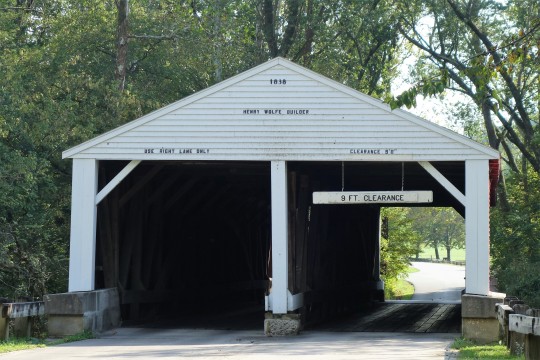




Days 32 & 33, Wed/Thurs Sept 29-30. 135 miles & 120 miles.
Hit the road Wednesday morning headed for BMW motorbike shop in Indy for some rear brake pads, then on to Glenwood to see my Aunt Mary Lynn & Uncle Tim. My grandparents lived in Rushville, which I went thru on the way to Glenwood. As a child, my family went to Rushville several times a year, including all major holidays. Miss them. I was the ring bearer in Mary Lynn and Tim's wedding. Happy to be seeing them!
Tim made his world famous meat loaf (it is!), Mary Lynn cooked it perfectly along with mashed potatoes, green beans and biscuits. All so dang good! They treated me like a king. I think they invented Hoosier Hospitality. Always great to spend time with them and this time didn't disappoint. Thank you Mary Lynn & Tim!
That makes 10 bed nights in a row - party's over Thursday night.
Got up Thursday and headed back to Indy to see my Sis Chris. Yea, back tracking, kinda, 'cept I took a different route. Found a great little restaurant called Fire on the Monon. Since I was still in Indiana, figured I'd best get a Tenderloin sandwich. Holy Schnikey! Yes, there was a bun, lettuce, tomato, onion and pickles under that fried frisbee. We had a nice visit on Chris' back patio, then off I went for Brown County State Park. Chris looked great - girl just doesn't age! Hubby Dave was working out of town - next time Dave!
Highway 46 into Brown County SP was very nice, as was the park itself. Beautiful place - rolling hills and LOTS of trees. Unbelievable Fall Colors in a few weeks. Campground is sold out for the entire month of October. Ogle lake, North Lookout Tower.
2 notes
·
View notes
Text
The Apple
This is a Hamilton tickle fic!
Summary: Philip has a lot in common with his parents, a little bit too much in fact.....
It all started with a simple phrase: The apple doesn’t fall far from the tree.
And it is something that is universally known: Like parent like child, like mother like daughter, like father like son.
Children often take things from their parents. Wether it be their eyes, their smiles, their shapes, their love of reading, their athletic skills, their talent or all of the above.
And in nine-year-old Philip Hamilton’s case, the statement could not be more true.
Philip had his mother’s smile and soothing voice, he had his father’s determination and dedication, he had both of his parents love and compassion. And he most certainly had the mischief passed down from both sides of the family.
The day Thomas Jefferson had met Philip, he had referred to him as a mini Alexander. This of course didn’t go down too well with Hamilton, because Jefferson was prone to using ‘Alexander’ as an insult. Yet little Philip didn’t mind, and even asked Thomas why.
“Why?”, Thomas repeated, “Your confidence, your pride, your posture”. And as Alexander was walking Philip home that night, he heard Jefferson mutter from behind them, “And his annoyingness”.
Luckily, Philip hadn’t heard that.
Another time that somebody had made a similar comment about Philip’s similarities with his parents was when his grandfather of the same name had stated: “Wow! You look identical to your mother when you smile!”. Alexander had shrugged, kissing his wife, “I know, it’s beautiful isn’t it?”.
But by far the most interesting time this had happened was on one sunny July afternoon.
Philip, Alexander, Eliza, Burr and Angelica were all having a picnic at the park. Philip was preoccupied with throwing crumbs of his jam donut at the ducks in the lake, despite the fact that his parents had told him not to. Again, the Hamilton-Schuyler mischief.
Philip crouched down by the lake, extending an arm out with a small crumb in it. A small fluffy brown duck paddled up to him and started nibbling it from the young boy’s freckled fingers.
“Daddy daddy look!” Philip cried in delight, as more ducks swam towards him.
Alexander gasped, “Philip, no!”. He ran up to his boy and lifted him up by his torso. “Put me down!” he said, struggling, “The ducks are hungry!”
“Philip Hamilton, you should know better than to be crouching down beside the lake, you could have fallen in and got hurt!”, Alexander exclaimed.
“But the ducks are so cuuuute”, Philip whined, as Alexander marched him back to the picnic blanket.
“Wow”, Burr remarked, “The kids determined, like you Alexander!”
“The apple doesn’t fall far from the tree” Eliza said, as Alexander placed the small boy on her lap. Philip sat up and pricked his ears up: “What does that mean?”.
Aaron Bur, having been a prized language student, smiled and explained, “You know how apples sometimes grow on trees?”.
“Yes” Philip said in interest. “Well”, Burr said, “You grew from your parents. And when apples fall, they land close to the tree they fall from. Like how you are close to your parents!”.
“Ohhhhh”, Philip said, “I get it now. But wait, what if a bird swoops down and carries the apple away from the tree?”.
The adults all laughed gently. “Outside of the box thinker”, Angelica said, “Just like your mother”.
Philip tilted his head to the side: “Are you saying that I look like a box to you, Auntie Angie?”.
The adults all laughed again, and Burr leaned over to poke Philip in the side playfully. The freckled boy squealed and jumped, making everyone smile.
“And there is something else he has in common with his father”, Eliza stated, fluttering her fingers against the ribs of the boy below her, “He’s insanely ticklish!”.
“Muhum!”, Philip giggled, squirming around, “Stohohohop!”
Eliza stopped and smirked up at her husband, who’s face was redder than a tomato. Philip jumped out of Eliza’s arms and jumped at his dad, tackling him down to the grass.
“Yeah, pops is very ticklish!” Philip exclaimed, before clawing his little fingers into his father’s belly.
Alexander burst out laughing, only squirming lightly as not to hurt his son.
“Pihihiihihip, stohohohohop it! Plehehehehase!”.
“Ah, no”, Philip stated, keeping up his attack. The other adults all watched fondly, smiles on their faces.
“Hey, little buddy”, Burr said, tapping Philip on the shoulder, “Have you tried out his tummy button yet?”.
Philip smiled up at him before dipping his finger into the dreaded spot.
“NOHOHOHO PIHIHIHIHP, NOHOHOHOT NIHIHIHIHIHICE!”.
Burr grinned: “Oh, it must be nice”, he said, joining in with Philip and tickling Alexanders neck. Alexander squealed and pinned it to his chest: “NOHOHOHOHOHHO BUHUHUHUHURR!”.
“Hey, hey”, Burr said, putting a finger to his lips, “Talk less”. He dug his hands under the mans arms, wiggling his fingers into the hollows, “Smile more”.
Alexander collapsed in laughter, from both his son’s tickles and his friend’s tickles.
“Ok”, Eliza chuckled in amusement,”Guys, don’t get carried away, you don’t want to kill him! Have a lettuce sandwich”, she offered.
Burr stoped and took the sandwich: “Thanks Eliza”. Yet Philip was still tickling his dad’s stomach and sides.
“Lettuce, eww!”, he remarked, not slowing his attack one bit.
“EHEHEHEHEHEHAT YOUR VEHEHEHEHEGETABLES!”, Alexander cried, kicking his legs out a little bit. A wide grinned sread across Philip’s face, “Nah, I’m hungry for something else pops”.
Philip lifted up his dad’s shirt and lowered his head to his stomach.
Alexander’s eyes widened, “No,Philip, don’t you dare”.
Philip chuckled, causing Alexander to start wiggling from just the feeling of his son’s breath on his stomach, “I’m sorry daddy, but you do this to me all the time. I deserve a bit of revenge!”
And with that, Philip inhaled and blew.
“BAHAHAHAH PHIHIHIHIHILIP NOHOHO!”.
“Philip yes!”, the boy exclaimed, inhaling before blowing another one.
“SHIHIHIHT AHAHAHAHA!”.
“Alexander!”, Eliza exclaimed, shocked by the language coming from his husband’s mouth, “Not in front of Philip”.
“SOHOHOHHOHOHOHORRY!”, Alexander laughed, as Philip went to squishing the sides of his belly.
“NOHOHOHOHO, ANYTHING BUT THAHAHAHAT!”.
Eliza smirked, “You know, I was going to help defend you Alexander, but because of your foul language, I know longer feel motivated to do so”.
“EHEHEHELIZA!”
“That’s my name”, Eliza teased, poking at his husbands hips a bit.
“NAHAHAHAHA ENOHOHOHHOUGH!”.
Eliza giggled and pulled her son off her husband lightly: “Come on Philip, he deserves a break”.
Philip giggled and sat up, running into Auntie Angie’s lap. Angelica humphed, Philip was getting to be really big!
“I think a puberty growth spurt is just around the corner”, Angelica remarked.
Philip looked up at her, “What’s puberty? Will it make me stronger!”.
Philip flexed his muscles, and Angelica snuck a tickle under his arms.
“H-hey!”, he giggled, pinning them down to his sides.
Angelica shrugged cheekily, “It’s time to bring justice to your poor father!”. She wiggled her fingers up and down Philips belly and torso.
“Nohoho, Ahahahahangie”, the boy giggled, squirming lightly in his auntie’s arms.
“Sorry Pip, all in the name of justice”, Angelica teased.
“Yeah!”, Alexander remarked from the other side of the picnic rug, “Next time you’ll think twice about tickling your father!”.
Angelica dipped her finger into Philip’s button.
“SHIHIHIHIT!”.
Everyone gasped, and Angelica stopped.
“Philip, don’t say that word!”, Angelica remarked.
“Yeah”, Eliza added, “Your father’s a bad influence”.
Philip chuckled and smiled at his mother: “The apple doesn’t fall far from the tree”.
Haha thanks for reading! Please give feedback!
#fluff#hamilton fluff#hamilfam#hamiltontickle#hamilton tickle fic#lee!alexander#ticklish!hamilton#ticklish!philip#ler!burr
41 notes
·
View notes
Photo

Northern Cardinals are some of the most recognizable birds in the United States. The male Northern Cardinal, like the one pictured, is easily recognized by its bright red color, while the female Cardinal has a hue that’s more reminiscent of brown. Some suggest that the Cardinal should split in up to six different distinct species.
FIND MORE BIRDS HERE
INSTAGRAM
However, the more prominent theory is that two species exist that look nearly identical, but vocalize differently and mate separately. While more definitive research is necessary, the two species would consist of a Sonoran population in the western end of their range and a Chihuahuan population in the east.
Inspiration: For the Record - Torae
Taken: Lettuce Lake Park, FL 11-24-19 909AM
Nikon D7200 200-500mm f/5.6
#northern cardinal#cardinal#birds#birding#bird#bird photography#natgeo#nikon#nature#wildlife#wildlife photography#nature photography#red#everglades#florida#tampa#aesthetic#forest#woods#wood#tree#flight
141 notes
·
View notes
Text
Evinston, Florida
by Joanna Grey Talbot
Located on the border of Alachua County and Marion County is another sleepy town with a vibrant history.
The area was a part of the Arredondo Grant of 1817 and many of the early settler families went by the names of Reeves, Wolfendon, and Evins. The Evins family had moved from South Carolina (just like the Mathesons and Hailes) and eventually owned large land holdings west of Orange Lake.
In 1882 Captain William Drayton Evins gave land for the right-of-way for the Florida Southern Railroad. That same year he built his house, which still stands today and is owned by Ashley Wood, long-time Alachua County Historical Commission member.

Evins-Wood House, courtesy of Alison Eckerle - WUFT News
The post office was established on February 28, 1882. The depot wasn’t built until 1884 but it was named Evinston in honor of the Evins family.
Evinston was a thriving town with a variety of stores, schoolhouse (it consolidated with the Micanopy school in the 1920s), three churches, a blacksmith, two packing houses, and a grist mill.
A short article in the Gainesville Daily Sun on September 6, 1905, tells of the opening of the school year.
“The Evinston School, under the direction of Miss Vallie Grace, opened Monday under most favorable conditions, a good enrollment having been recorded the first day. Miss Grace is one of the most popular and efficient teachers in the county, and will no doubt make a fine success of the Evinston School.”
As most of Alachua County had been, Evinston had a number of citrus groves that were destroyed during the freezes of the 1890s. The local economy instead focused more on vegetables, melons, and cattle.
On February 8, 1907 the Gainesville Daily Sun reports that “the truckers [are] shipping a large quantity of lettuce from that section, which is as fine as was ever grown in Florida. The lettuce industry at Evinston is one of the most important in the section.”
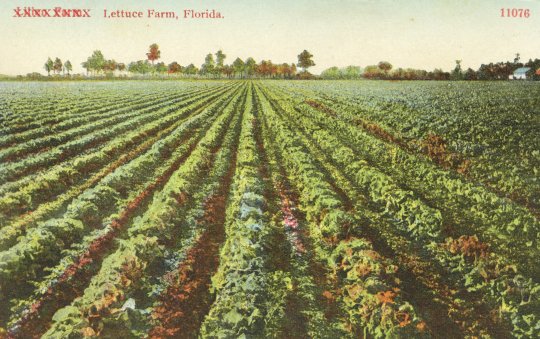
Lettuce Farm in Florida, courtesy of the Matheson History Museum collection
The melon industry was also booming at the time. In 1909 the Gainesville Sun reported:
“The melon and cantaloupe movement from this part of Florida is now at its highest, for nearly all sections are shipping this fruit with fine results being obtained. It has long since passed simple carloads, and from three to five extra melon trains are run over the A.C.L. from Ocala to this city, while it is about the same ratio over the Seaboard, the greater part of this fruit coming from the Evinston and McIntosh sections.”
In 1905 the Gainesville Sun reported that F. W. Barron from Evinston had sent them a 96 pound melon! He was a postmaster, merchant, and farmer. The paper thanked him for “both the melon and his thoughtfulness.”

Florida cantaloupes, courtesy of the Matheson History Museum collection
For a time Evinston also had a local baseball team. In 1906 the Gainesville Sun reported about a game between Evinston and Oak Hall. It was not the most exciting of games.
“Those who attended baseball at the park Thursday afternoon between the Oak Hall and Evinston teams expected to witness something exciting, but the contest was so one-sided that before the game was half over all interest was lost, and the spectators began munching peanuts, drinking lemonade and talking over the current events of the day, some even taking out their papers and glancing over the news. The Oak Halls found an easy thing, but the visitors did the best they could under the circumstances. The score was 11 to 3 in favor of Gainesville.”
In 1886 the Mt. Olive African Methodist Episcopal Church was established. The church held camp meetings for 2 weeks each year. They were so popular that the railroad would run excursions out to Evinston. The old wooden church was replaced by the current sanctuary in 1973.
The congregation of Evinston United Methodist Church began meeting in the 1890s in members’ homes and the one-room schoolhouse. Members would also somtimes go to a service in McIntosh and then back to Evinston for Sunday School class. The church builidng was constructed in 1909 and the laying of the cornerstone was covered by the Gainesville Daily Sun. It was a circuit church with Micanopy, McIntosh, and Shiloh. The Evinston church met on the third Sunday of each month. It wasn’t until the 1990s that they hired their first full-time pastor, Reverend Don Legler.

Evinston United Methodist Church, courtesy of the Evinston UMC
The railroad service to Evinston was discontinued in 1956 and the tracks were pulled up in the 1980s. Today Evinston is still a beautiful, small town and is home to the famous Wood & Swink Store. It was constructed in 1882 and became a general store around 1900. The store and post office changes owners multiple times until the Wood family bought it in 1906. It became the Wood & Swink in 1933 when Frederick Wood and his brother-in-law, Paul Swink, became co-owners. The Wood family continue to operate it and in 1989 it was placed on the National Register of Historic Places. You can still visit it today!

The Wood & Swink Store and Post Office, courtesy of the State Library and Archives of Florida
4 notes
·
View notes
Text
Housing
The median home cost in Asbury Park, New Jersey is $360,600. Home appreciation in the last 10 years has been 35.9% which is a 24.4% increase for the city. The median age of Asbury Park real estate is 56 years old. Renters make up 65.2% of the city's population and 4.3% of houses and apartments are available to rent. The average rental fee for a studio home or apartment unit is $1,028 while a one-bedroom unit averages $1,230. The average rental fee for a two-bedroom home or apartment unit is $1,598 while a three-bedroom unit is $2,171 and a four-bedroom unit is $2,469.
Coronavirus: NJ Issues Update After Other US Cases Announced
Health officials addressed the risk of the coronavirus appearing in the state after investigating NJ patients who showed symptoms. NEW JERSEY – State health officials have announced that they're taking steps to deal with the risk of the coronavirus appearing in New Jersey. Read more here.
With the outbreak of the deadly coronavirus giving the world a scare, state health officials from New Jersey are taking steps to prevent the virus from entering New Jersey. Two cases have been confirmed in the United States, specifically in Chicago and Washington state. Health officials say the risk of the coronavirus in New Jersey is actually low but has established a central webpage of resources to assist the public. Also known as "nCoV," the novel virus emerged in Wuhan, China in December 2019 and now globally includes more than 500 cases and 17 deaths. Symptoms of the ailment include cough, fever, and shortness of breath. They may appear in as few as two days or as long as two weeks after exposure.
The Great Auditorium in Asbury Park, NJ
The Great Auditorium in Asbury Park, NJ is the center of activity in Ocean Grove since it was constructed in 1894. It is considered to be the most impressive and largest enclosed auditorium in the city and is used for Sunday services in the summer. The auditorium also hosts showcases for well-known preachers and evangelists recognized throughout the world. Famous performers also hold concerts in this venue, while exhibitions and other entertainment are also held in the auditorium. The wooden building rests on bridge-like steel trusses that are laid on stone foundations. It also features numerous barn door entrances with colored glass, dormers, and panels that open for ventilation.
Some of the signature dishes that you can try at Asbury Ale House in New Jersey include Buffalo Chicken Eggrolls, Ale House Tenders, Cheesesteak Eggrolls, Mac and Cheese Bites, and Drunken Bites. They also have Ale House Favorites that include Firecracker Shrimp Lettuce Wraps, Drunken Chicken Sandwich, Chicken Avocado Club, and ALe House Burger. They also offer starters such as Hanover Fries, Breakfast Nachos, Breakfast Quesadilla, and Breakfast Tacos. The sports bar also offers a variety of Bloody Marys and Cold Brew on tap. In addition, they have a kids menu and also serve lunch specials. Visit them at 531 Cookman Ave, Asbury Park, NJ, and check out their entire mouthwatering menu!
Link to Map
The Great Auditorium
21 Pilgrim Pathway, Ocean Grove, NJ 07756, United States
Head south on Pilgrim Pathway
105 ft
Turn right toward Mt Zion Way
128 ft
Slight left toward Mt Zion Way
72 ft
Turn right toward Mt Zion Way
112 ft
Continue onto Mt Zion Way
0.1 mi
Slight left onto Asbury Ave
89 ft
Turn right toward Lake Ave
279 ft
Turn left toward Lake Ave
85 ft
Turn right onto Lake Ave
46 ft
Turn left onto Emory St
276 ft
Turn right onto Cookman Ave
102 ft
Asbury Ale House
531 Cookman Ave,
Asbury Park, NJ 07712,
United States
1 note
·
View note
Text
Windows
If you’ve ever stayed in a European youth hostel, you can picture the kind of room I’m in right now. It’s windowless and Spartan: twin beds, lumpy pillows, an ancient phone on a beat up nightstand between the beds. It’s cold in here because the air is cranked up too high, but there’s no thermostat. There’s also no clock. Time doesn’t matter here, and time also matters a great deal. The main difference between this room and a room at a cheap pensione in Florence is that when you step outside you’re not greeted by the picturesque banks of the Arno. This room is one of the two “sleeping rooms” in the Neonatal Intensive Care Unit at Providence Pavilion for Women and Children in Everett, Washington, and I’m here because my baby is across the hall, hooked up to machines.
I was 35 weeks and 5 days pregnant when I woke up at 1:18 am.
“My water just broke,” I said to Flo, and my heart sank. They had told me several days prior that I should “chill out” and “take it easy,” when I visited labor and delivery to talk about the symptoms I was having, which felt suspiciously like pre-term labor. I did do things differently: I stopped going to the gym. I started doing dishes while sitting on a bar stool (for what it’s worth, we should all be doing this. It’s comfortable.) But at the same time, a small voice inside me was egging me on: reminding me to finish little tasks, to tidy up loose ends. By Saturday, I was walking through Safeway with Ladybug slower than I’ve ever walked anywhere. I almost could have predicted I’d go into labor that night. But I was at the grocery store, because we needed milk. (It’s currently turning into yogurt in the fridge. Turns out, we’d never drink the milk after all.)
Regardless, there I was at 1:18 am, trying to be clearheaded about what to do next. I packed a few things (real talk: mostly snacks) and tried calling a couple of friends before realizing that Ladybug would be joining us at the hospital. Unsurprisingly, she was thrilled. She had already packed a bag in case she needed to stay at a friend’s house. But staying at the hospital? Even better. (The next morning she did head to a friend’s for the day, and stayed there that night as well. I’m all for including the family in life events, but I don’t need to be managing a five-year-old between earth-shattering contractions.)
Earlier that week I had gotten a pregnancy update email (baby was the length of a head of Romaine lettuce at that point, I think) which highlighted the need to map out the best route to the hospital. Flo and I giggled about this, thinking back on our interminable drives to and from UCLA Medical Center as we waited for Ladybug to arrive. To get to PeaceHealth Ketchikan, by contrast, the directions were straighforward: turn left out of driveway. Turn right on Carlanna Lake Road. Turn left into the ER. It took us a minute and a half to get there from our house, where we parked steps from the entrance of the ER by a sign that said “Reserved for Patients.”
I will not bore you with my birth story. Was it Chekhov who said, “Every happy family…?” Forget it, I just googled the phrase and will spare you my version (it’s Tolstoy, by the way. Also Russian, so arguably I was close.) “All happy families are alike; each unhappy family is unhappy in its own way.” This is true for childbirth too. Every birth story is unique and gnarly and often funny, and the ones that go haywire are unhappy in their own ways. But if you’ve heard one birth story you kind of get the idea: the built-in spoiler alert is that it ends with the birth of a baby. As wild as the story may be, the ending is almost universally the same. All I will say is that Flo and I were holding our son at 5:43 pm, sixteen hours after we packed up our little bag and our little girl and left for the hospital. I am in love with the name we chose for him, but for the purposes of this blog he will be known as Bronson. (Long story. Ask Flo.)
Anyway, in our case it wasn’t labor and delivery that made for the interesting story. A few hours after birth, after the little man had crawled his way up my chest like his sister had done and rooted around for some dinner, the nurses noticed he was struggling to breathe. So began several days of cannulas in his nose to send air more easily to the lungs, and then an IV drip to regulate his blood sugar, and then a 24-hour moratorium on breastfeeding so he wouldn’t aspirate, and then and then and then. In the same way that they say one intervention in labor can lead to a snowball effect, it felt as though Bronson was encountering more and more obstacles day by day. But he seemed well enough by Thursday morning that we were talking about being discharged the next day. Then he stopped breathing. He was in my arms in the tiny nursery—he’d been in my arms most of the night—and he suddenly seemed sleepy. The night shift nurse stared hard at the monitor, adjusting the leads that connected him to it. Within moments, our quiet night together turned loud, bright, busy. A team of nurses, doctors, anesthesiologists, respiratory specialists—they all got to work, drawing blood, inserting a new IV, pumping air back into his lungs. It was quickly decided we would need to be medevaced to to a bigger facility with a proper NICU, which meant Flo raced home to pack me a bag. Ladybug and I cried softly in each other’s arms.
Bronson and I were loaded onto an ambulance, which drove onto the airport ferry, which then headed around the backside of the airport to a police escort and a waiting Lear jet. Bronson’s tiny body was dwarfed by the enormity of his incubator. The kind man who worked for LifeMed and sat next to me on the plane briefed me on flying in a Lear jet: basically, it goes very fast, and might make you sick, and you’ll get there in no time.
The whole time we were in the air, I honestly felt like I was dying. I was semi-reclined (perhaps in a nod to my recently revoked status as a patient.) I couldn’t breathe well, and it felt as though the top of the plane was pressing down on my chest. I stared out the window at the clouds and drifted off, out of exhaustion and terror. I couldn’t see my baby, but partway through the flight, the EMT who was sitting next to him asked for my phone. She took a picture of my beautiful boy, his eyes open and bright. He seemed to be doing better than I was.
We landed in an airfield in Everett and a firefighter walked me to the bathroom in a huge hanger. The whole thing felt so absurd that I wanted to make a joke, but for once in my life I really couldn’t think of anything to say. So I said thank you. En route to the hospital, the ambulance driver pointed through the window at the largest building in the world (so he said); a huge sign on the front of it said Boeing. I felt like I did the first time I stepped off the subway in Tokyo—that everything was big, foreign, pulsing with life in a language I didn’t understand. Bronson had another apnea episode when we arrived at the hospital but I wasn’t there to see it. I had been shunted upstairs to Admitting, where a woman who looked exactly like Iris Apfel spent ten minutes misunderstanding our primary insurance. (I think it’s in the middle of Mr. and Mrs. Smith that Angelina Jolie and Brad Pitt get into an elevator and hear The Girl From Ipanema; after a few seconds of calm and muzak, they get to the next floor and step out, guns blazing. This is what it felt like in Admitting.) Soon, though, I was back downstairs, staring into Bronson’s room as a soft spoken doctor stood next to me and plied me for information about what had happened. I turned to him.
“To be clear,” I said, asking the thing I realized I’d been wondering all day. “This isn’t a question of, ‘My baby may not make it.’ Right…?”
“No,” he said firmly. “He will be fine.”
Still. After my baby settled down for the night, his room buzzing with machines, his body a tangle of wires, I wandered across the hall to the sleeping room and made a few sobbing phone calls. I was decidedly not okay, because I was pretty sure my baby wasn’t either.
That was ten days ago. It’s been two weeks since I glanced around my living room to make sure I hadn’t forgotten anything, turned off the lights and drove away. Two weeks since I wandered the halls of PeaceHealth Ketchikan, looking through the windows at the wintry darkness between mind bending contractions. Two weeks since they said, “Pushpushpushpushpushpush,” and I did and I did and I did and then I held a small red-faced boy in my arms and cried. Two weeks of living in hospitals, he and I — and things seem easier. I chatted with a couple of nurses just now, using words I didn’t know two weeks ago, talking diagnoses and comparing the opinions and temperaments of attending neonatologists. Bronson can breathe on his own, though we’re still figuring out the root cause of his problem, which (it’s becoming clear) may extend beyond his prematurity and into something congenital or structural. Stay tuned; when I know, you’ll know. He’s eating, and sleeping, and pooping, and generally doing all the things babies do.
The other day, Flo smiled a little when he saw the blankets in the sleeping room. (He and Ladybug and my mom are staying at a Hampton Inn a few blocks away, which feels like the premise of a bad sitcom.) “We used to have these blankets in our house,” he said. This baby, our baby, who lives in a crisp clean room in a state of the art hospital — his grandfather raised five children as a single dad cleaning hospitals like this one. Our little guy has his middle name. There’s been so much talk in the last few years about privilege, but I’ve come to realize from this experience that privilege extends beyond race, class, gender, and so much else that we’ve addressed in the conversation. Privilege extends to access. Privilege extends to the ability to be relieved of pain and suffering. (That is, at least as far as medically possible.) Privilege means a shared language, and the ability to speak up for ourselves. Privilege gives us a window to look through: we can choose to see all the beauty others seem to have that we have been denied, or we could recognize the beauty we ourselves have been given that others may not have access to. All we have to do is open the window, and breathe. It’s the breathing, of course, that is the hard part. But we’re working on it.
5 notes
·
View notes
Text
Branta
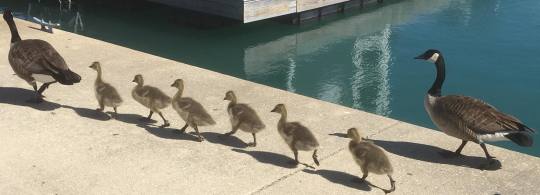
Canada Geese family, by Me!
PLEASE SUPPORT US ON PATREON. EACH and EVERY DONATION helps to keep this blog running! Any amount, even ONE DOLLAR is APPRECIATED! IF YOU ENJOY THIS CONTENT, please CONSIDER DONATING!
Name: Branta
Status: Extant
First Described: 1769
Described By: Scopoli
Classification: Dinosauria, Saurischia, Eusaurischia, Theropoda, Neotheropoda, Averostra, Tetanurae, Orionides, Avetheropoda, Coelurosauria, Tyrannoraptora, Maniraptoriformes, Maniraptora, Pennaraptora, Paraves, Eumaniraptora, Averaptora, Avialae, Euavialae, Avebrevicauda, Pygostylia, Ornithothoraces, Euornithes, Ornithuromorpha, Ornithurae, Neornithes, Neognathae, Galloanserae, Anseriformes, Anseres, Anatoidea, Anatidae, Anserinae
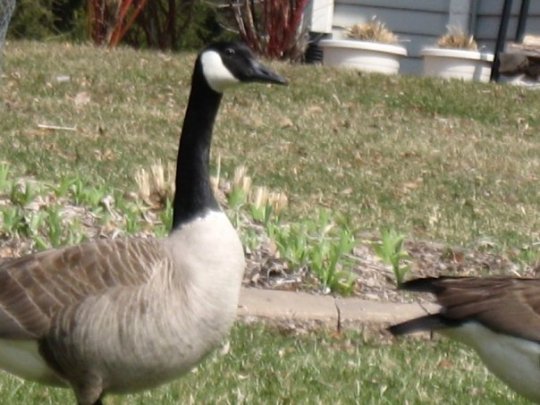
Canada Goose by Me
Referred Species: B. bernicla (Brant Goose, extant), B. ruficollis (Red-Breasted Goose, extant), B. sandvicensis (Nēnē, extant), B. hylobadistes (Nēnē-Nui, extinct), B. rhuax (Giant Hawai’i Goose, extinct), B. canadensis (Canada Goose, extant), B. leucopsis (Barnacle Goose, extant), B. hutchinsii (Cackling Goose, extant), B. woolfendeni (extinct), B. thessaliensis (extinct), B. dickeyi (extinct), B. esmeralda (extinct), B. howardae (extinct), B. propinqua (extinct), B. hypsibata (extinct)

Read-Breasted Goose by Tony Hisgett, CC BY 2.0
Our last entry in this triple-whammy punch of large genera - Branta, the black geese! These include geese from the northern regions of North America and Europe, extending into more temperate regions of North America as well. Being called Black Geese, most have black coloration on their bodies, usually the neck, though the Red-Breasted Goose is also black for most of its body. Their legs and feet are also black or at least very dark grey, which sets them apart from other geese - in addition to being usually smaller, though some are quite large. Those found in Europe are more coastal than the geese of the genus Anser, though those found in North America are found throughout the continent.

Nēnē by Francis C. Franklin, CC BY-SA 4.0
The first specimens of Branta are reported from about 15.97 million years ago, in the Langhian of the Miocene, though these are fairly suspect and its probable that Branta did not appear until later in the Miocene. They probably first appeared in North America, though that is under some debate. B. woolfendeni is known from the Late Miocene of Arizona and one of the earliest known species. B. thessaliensis is known from the Late Miocene of Greece, indicating this bird diversified rapidly if it is from North America. B. thessaliensis also indicates that Branta lived across climate zones prior to the Ice Age, and is only restricted to its current range due to adaptations through the Ice Age. B. thessaliensis is also, interestingly, about the size of the living Canada Goose. B. dickeyi is known form the Pliocene of the Western United States, and B. esmeralda is known from the Early Pliocene of Europe, as is B. howardae. B. propinqua and B. hypsibata are both known from the Pleistocene of Fossil Lake in the United States.

Bernache Goose by Ludovic Péron, CC BY-SA 3.0
Hawai’i back in the day sported two very distinct geese, the Giant Hawai’i Goose and the Nēnē-Nui. The Giant Hawai’i Goose, B. rhuax, lived in the earliest portions of the Holocene, and it is the first fossil bird to be described from Hawai’i. The bones of the bird are rather warped due to lava flow, though it appears to be bigger than other Hawaiian geese and might be as large as the living Cape Barren Goose of Australia, which weighs up to 7 kilograms, though its difficult to tell due to the warped bones. The Nēnē-Nui, or B.hylobadistes, also lived in the Holocene of Hawai’i, specifically Maui, Kaua’i, O’ahu, and possibly Moloka’i. Many subfossils are known of this bird, which indicate it was similar to the living Nēnē. It was evolving towards flightlessness, with most fossil individuals show diminished flight capability at best, with some showcasing flightless individuals with diminished wings. This is one of the few fossil species showing the evolution of the process of flightlessness, rather than the end result. They weren’t completely reproductively isolated from the Nēnē, which was slowing down this process. They went extinct soon after human arrival on the islands.

Brant Goose by Andreas Trepte, CC BY-SA 2.5
The earliest derived living species of Branta is the Brant Goose, a rather small goose with a short and stubby bill and darker, less characteristic plumage than other species in this genus. There are three subspecies, all separated by their particular brand of coloration. These birds spend the summer in Arctic coastal regions of North America and Eurasia, then wintering in more southern portions of these continents and even in Northern Africa. There are permanent populations of these geese, most notably in the United Kingdom, Pacific Coast of the United States, and New England. They weigh up to 2.2 kilograms, making them very small geese indeed.
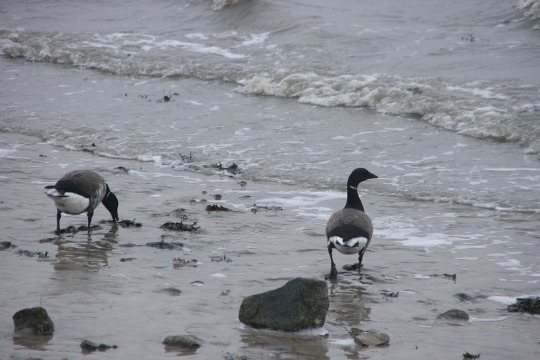
Brant Geese by Henrike Mühlichen, CC BY-SA 3.0
These geese are mostly coastal birds, primarily found in tidal estuaries where it feeds on various sea plants such as seaweed, sea lettuce, and eel-grass. However, some have moved more inland, feeding on agricultural products such as cereals and grass, potentially copying other geese in doing so. They are considered to be not threatened with extinction, though some North American populations have been badly hit in the past.

Red-Breasted Goose by Iorentey, CC BY 2.0
Even more visually distinct from other members of the genus than the Brant Goose, the Red-Breasted Goose is seemingly a visual outlier - with red feathers on its neck and chest and black and white feathers all over its body, it looks like it should be a completely different type of goose. And yet, it is not. B. ruficollis is known primarily from Eurasia, breeding in Siberia and migrating down to Eastern Europe and Central Asia during the winter. These birds are vulnerable to extinction, due to limited sites utilized during the breeding season, sites that are threatened due to human land use. Conservation efforts are ongoing in attempts to preserve the species.

Red-Breasted Goose by Dick Daniels, CC BY-SA 3.0
The Red-Breasted Goose usually weighs only about 1.5 kilograms, making it a very small bird indeed. It makes a shrill and staccato call, and despite its small size it actually prefers to nest alongside birds of prey like owls and falcons, which helps to protect their eggs from mammal predators. The birds of prey protect the geese from predators, and rarely attack them themselves. They have very large nesting colonies, which also contribute to safety in their habitats. They also nest on rivers and islands, but they prefer using birds of prey for protection instead. THeir colonies have usually about 4 pairs, though there can be more if food is abundant, and they rarely leave a 1.5 kilometer radius of the nest. The males guard the young from a distance, while the females roost on the nest. They feed mainly on grasses, leaves, and seeds.
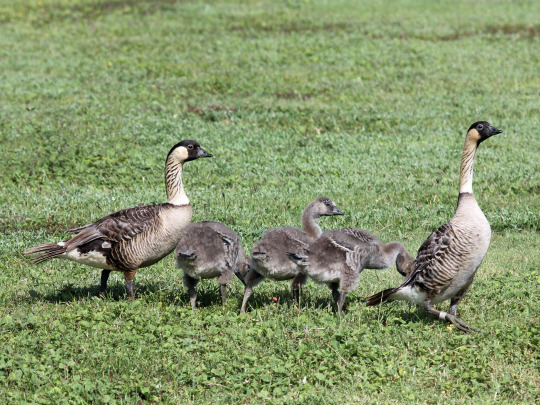
Nēnē by Dick Daniels, CC BY-SA 3.0
The Nēnē is where we finally start inching towards the common color pattern of Branta, though it is browner potentially as an adaptation for a more terrestrial lifestyle. It is a goose endemic to Hawai’i, and is the state bird of Hawai’i! It is found on Oahu, Maui, Kaua’i, Molokai, and Hawai’i itself, in terms of specific islands, and its name comes from its soft call. It is the world’s rarest goose, almost driven extinct due to human activity and introduced mammal predators (thanks, humans). Today, conservation efforts and breeding programs have successfully gotten the population from 30 birds to 2,500 birds, though it’s still considered vulnerable and efforts are heavily ongoing.

Nēnē by Caracas1830, CC BY-SA 2.5
The Nēnē is about 8.6 kilograms in weight, and it is closely related to the Canada Goose, and may have even evolved from it, though that is under some debate. They spend most of their time on the ground and have very distinctive feet, widely splayed flippers that give them more surface area while walking on the ground. They are capable of flight, however, though they still primarily live inland in shrubland, grassland, dues, and lava plains. They feed on leaves, seeds, fruit, and flowers as well as grass and shrubs. They breed from August to April, so for a long period of time, longer than any other goose species. They nest on land, unlike other waterfowl, and the female lays between one to five eggs and incubates them for about a month, while the male guards. The goslings then stay with their parents until the next breeding season.

Canada Goose by Daniel D’Auria, CC BY-SA 2.0
The Canada Goose, B. canadensis, is arguably the most famous goose - at least to people in America - due to it rather common state. It is native to the arctic and temperate regions of North America, and it does extend into northern Europe, introduced into the United Kingdom, New Zealand, Argentina, Chile, and the Falkland Islands. These birds are very successful in living in urban areas, to the point where I can’t really go anywhere in Chicago (my home) without seeing one. They tend to breed well in park areas, and they beg for food from humans around them, which just kind of exacerbates the problem. Honk.
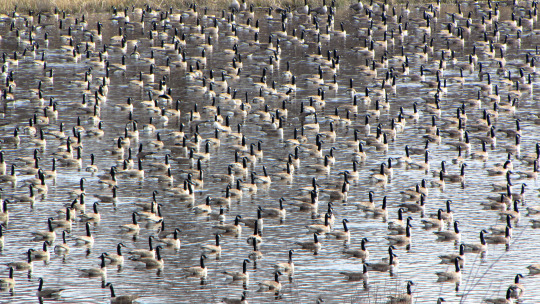
Canada Geese by D. Gordon E. Robertson, CC BY-SA 3.0
Canada Geese were, at one point, threatened with extinction due to over-hunting and human activity (most notably aircraft strikes), but conservation efforts for this bird may be too successful, with between 4 and 5 million birds estimated in North America alone, in the year 2000. Today, culls of geese in densely populated areas occur, but the bird is still protected under environmental laws and is not legal to be hunted most times of the year. I personally don’t ultimately see a problem with this in North America. In Eurasia, their introduction does pose a threat to agricultural and native goose populations, and introduction in New Zealand also threatens agricultural practices, making their presence in these regions a serious problem.
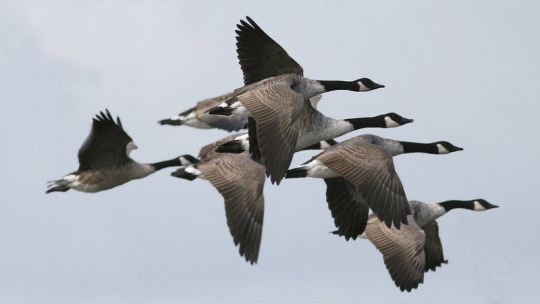
Canada Geese by Ken Billington, CC BY-SA 3.0
These birds weigh up to 10.9 kilograms, though they usually don’t exceed eight kilograms, and have very large wingspans that aid in their long flights and migrations. They have a distinctive white chinstrap on their black heads, and brown feathers throughout the bodies, as well as black legs and necks. Migratory birds, they form V-shaped flying formations while moving across North America during the spring and autumn. They usually spend the summers in Canada, and the winters in Southern United States, with year-round birds found in the Northern United States (so, you know, where I live). (They’re everywhere).
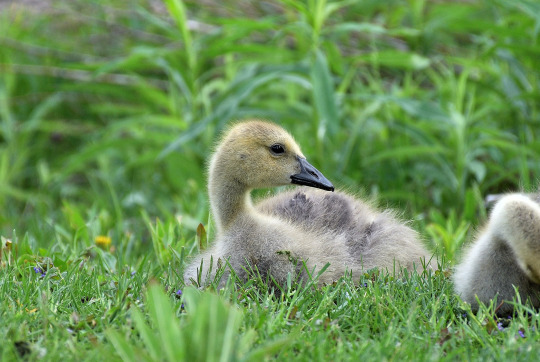
Canada Gosling by Saud, CC BY-SA 4.0
The Goslings are yellow and grey, becoming more grey as they age and then receiving adult plumage when they reach sexual maturity. The geese are monogamous, usually staying with the same mate for their whole lives, unless they are widowed at which point they find a new mate. The female lays two to nine eggs and incubates them, while the male finds food and tends to wander around. They nest near streams, lakes, and ponds for about 28 days. The goslings are immediately capable of walking, swimming, and finding food, with the parents leading the goslings in a line with one adult at the front and the other at the back, and the adults are violently protective of their chicks. Though, speaking from experience, if you’re a small child just reading a book by the pond and a bunch of geese start gathering around you, they probably won’t mind your presence. And might even remember you. So for their lifespan of ten to twenty four years they might just continue to be chill with your presence at the pond by your house. But that’s just my guess. The offspring fledge at about 9 weeks and dont’ leave their parents until they return to their birthplace.

Barnacle Goose by Andreas Trepte, CC BY-SA 2.5
The Barnacle Goose is next on our series of black geese, and it is in fact blacker than the geese we have seen so far, with distinctively dark necks and more monochromatic plumage. They weigh up to about 2.23 kilograms, making them fairly small as far as geese go. They are known primarily from Eurasia, breeding up in Greenland, Scotland, Ireland, Norway, and the Netherlands. Some have managed to migrate to the United States and Canada, but these expansions are rare, and oftentimes a wild Barnacle Goose is just a mistaken escaped one (they are popular waterfowl to collect, apparently).

Barnacle Geese by MPorciusCato, CC BY-SA .30
These geese build their nests on high mountain cliffs away from predators and food, and rather than adults bringing food to their goslings, the goslings go out to get their own food! The three-day-old goslings fall off the cliffs and their small size and feathery down help to protect them when they hit the rocks below, but oftentimes they just straight-up die, so that’s... a thing. Arctic foxes then prey on many of them as the adults lead them to wetlands for gathering food. Still, the Barnacle Goose does not appear to be threatened with extinction. Their weird mode of reproduction has lead to many legends being woven about them, such as that they came from driftwood; they are so different from other waterfowl that there’s a separate kosher ruling about them, decreeing that they are, in fact, kosher. But I wouldn’t eat them regardless.

Cackling Goose by Tim Bowman, in the Public Domain
The Cackling Goose is our last member of the genus, and it is essentially indistinguishable from the Canada Goose, with lots of overlapping range. They were made into a full species in 2004, though frustration amongst ornithologists remains because, again, they look the same. Still, they do extend into other locations, notably Russia; and they tend to be smaller than Canada Geese on average, but some can weigh up to 3 kilograms and approach the size of Canada Geese. They nest in shallow depressions near the water, in locations lined with plant material. They mate for life, and they will also parade their goslings, in order to reach plant material. They even can tip forward to feed on aquatic plant material, in a sort of dabbling pose. Sometimes they also eat insects, molluscs, and crustaceans. They do not appear to be threatened with extinction. Still, just to drive home how aggravating these birds are, they are probably most closely related to Barnacle Geese, not Canada Geese. There you have it.

Cackling Goose, by Tim Bowman, in the Public Domain
Sources:
https://en.wikipedia.org/wiki/Branta
http://fossilworks.org/?a=taxonInfo&taxon_no=83426
https://en.wikipedia.org/wiki/Branta_thessaliensis
https://en.wikipedia.org/wiki/Branta_rhuax
https://en.wikipedia.org/wiki/N%C4%93n%C4%93-nui
https://en.wikipedia.org/wiki/Brant_(goose)
http://www.luontoportti.com/suomi/en/linnut/red-breasted-goose
https://en.wikipedia.org/wiki/Red-breasted_goose
https://en.wikipedia.org/wiki/Nene_(bird)
https://en.wikipedia.org/wiki/Canada_goose
https://en.wikipedia.org/wiki/Barnacle_goose
https://en.wikipedia.org/wiki/Cackling_goose
#goose#black geese#branta#dinosaur#duck#bird#birblr#palaeoblr#canada goose#brant goose#barnacle goose#cackling goose#red-breasted goose#nene#nēnē#factfile#dinosaurs#biology#a dinosaur a day#a-dinosaur-a-day#dinosaur of the day#dinosaur-of-the-day#science#nature#branta bernicla#branta leucopsis#branta canadensis#branta hutchinsii#branta ruficollis#branta sandvicensis
75 notes
·
View notes
Text
Picnic Spots in Tampa FL
Tampa and its encompassing rural areas are hosts to north of 20 medical clinics, four emergency rooms, and various Cancer therapy focuses. Three of the space's clinics were positioned among "America's best emergency clinics" by U.S. News and World Report. Tampa is likewise home to numerous wellbeing research establishments. The significant clinics in Tampa incorporate Tampa General Hospital, St. Joseph's Children's and Women's Hospital, James A. Haley Veterans Hospital, H. Lee Moffitt Cancer Center and Research Institute, and the Pepin Heart Institute at Advent Health Hospital. Shriners Hospitals for Children is situated in Tampa. USF's Byrd Alzheimer's Institute is both a noticeable exploration office and Alzheimer's patient consideration community in Tampa. Alongside human medical care, there are many creature clinical focuses including the Humane Society of America.

Lettuce Lake Park: Lettuce Lake Conservation Park is one of Hillsborough County's most visited parks. More than half of the park’s property lies in the natural floodplain of the Hillsborough River, consisting of a hardwood swamp forest. The remainder of the park consists of hardwood hammocks and pine flatwoods plant communities. The park is located at 6920 East Fletcher Avenue Tampa, FL 33637 and you can contact the administration by (813) 987-6204 for more information.
Are you looking for the best picnic spots in Tampa, FL? Here they are,
1. Picnic Island Park: We are located at 7404 Picnic Island Blvd, Tampa, FL 33616, United States and you can contact us by call at +1 813 274-8615.
2. Ballast Point Park: The park is situated at 5300 Interbay Blvd, Tampa, FL 33611, United States and you can visit the park any day of the week from 6 am-8 pm.
3. Lettuce Lake Park: Lettuce Lake Conservation Park is one of Hillsborough County's most visited parks. More than half of the park’s property lies in the natural floodplain of the Hillsborough River, consisting of a hardwood swamp forest. The remainder of the park consists of hardwood hammocks and pine flatwoods plant communities. The park is located at 6920 East Fletcher Avenue Tampa, FL 33637 and you can contact the administration by (813) 987-6204 for more information.
Member Spotlight:
Made2Macro
2924 West Tyson Avenue, Tampa, FL, US, 33611
8138921393
www.made2macro.com
Since 2017, Made2Macro has dealt with quality Meal delivery services all around the city. Call us today to begin your custom prepared meal package services.
Get Map Directions
https://goo.gl/maps/9iVhQjJeRPmyQAnx8
1 note
·
View note
Text
Drink Up! Most of Us Could Benefit From More Water
By Jane E. Brody, NY Times, July 9, 2018
In reading about the risks and consequences of dehydration, especially for the elderly and anyone who exercises vigorously in hot weather, it’s nothing short of a miracle that more of us hadn’t succumbed years ago to the damaging physical, cognitive and health effects of inadequate hydration.
Even with the current ubiquity of portable water containers, far too many people still fail to consume enough liquid to compensate for losses suffered especially, though not exclusively, during the dehydrating months of summer.
For those of you who know or suspect that you don’t drink enough to compensate for daily water losses, the good news is you don’t have to rely entirely on your liquid intake to remain well-hydrated.
Studies in societies with limited supplies of drinking water suggest you can help to counter dehydration and, at the same time, enhance the healthfulness of your diet by consuming nutritious foods that are laden with a hidden water source. Plant foods like fruits, vegetables and seeds are a source of so-called gel water--pure, safe, hydrating water that is slowly absorbed into the body when the foods are consumed.
That’s the message in a newly published book, “Quench,” by Dr. Dana Cohen, an integrative medicine specialist in New York, and Gina Bria, an anthropologist whose studies of the water challenges faced by desert dwellers led to the establishment of the Hydration Foundation, a nonprofit group that promotes understanding and consumption of nonliquid sources of water.
More about these foods later. First, I must convince more of you that remaining well hydrated is crucial to your health. However solid your body, the majority of it is water, ranging from 75 percent of the body weight of infants to 55 percent of the elderly. Every bodily process, every living cell, depends on water to function properly. Water transports nutrients, regulates body temperature, lubricates joints and internal organs, supports the structure of cells and tissues and preserves cardiovascular function. People can survive for only three or four days--a week at most--without water.
But more to the point is the quality of survival. Inadequate hydration can cause fatigue, poor appetite, heat intolerance, dizziness, constipation, kidney stones and a dangerous drop in blood pressure. Brain effects include mood shifts, muddled thinking, inattentiveness and poor memory. A loss of only 1 to 2 percent of body water can impair cognitive performance, according to studies at Virginia Polytechnic Institute and State University.
Your body’s water balance is determined by how much you consume, your age and activity level and environmental conditions. The body loses water through the skin, lungs, kidneys and digestive tract; in other words, by sweating, breathing and elimination of waste, both liquid and solid.
“Water needs can vary from person to person--and no one person will need the same amount of fluid from one day to the next,” the Virginia scientists wrote in the American College of Sports Medicine’s Health and Fitness Journal.
The typical American consumes about one liter--a little over four cups--of drinking water a day. But people like me who engage in quasi-vigorous physical activity daily need more, and those who exercise strenuously for more than an hour a day need even more than that. Keep in mind that skimping on your liquid intake or relying on sugary drinks can take a toll on your physical performance.
If you’re planning to engage in strenuous exercise or do physical work outdoors on a hot day, it’s best to start hydrating the day before. Check the color of your urine; the paler it is, the better. Also continue to drink water or other fluids throughout your activity and for hours afterward.
A critical factor in remaining well hydrated is not to rely on thirst to remind you to drink but rather to be proactive by consuming enough liquid before, during and after meals and physical activity. The longstanding advice to drink eight glasses of water a day was something I (among many others) was never able to achieve. I’m happy to say that experts have since modified that rule. Current thinking calls for getting about 70 percent of daily water needs from liquids (including coffee and tea, by the way, though not alcohol) and the rest from solid foods.
The authors of “Quench” suggest two dozen fruits and vegetables that are especially hydrating, ranging from cucumbers with 96.7 percent water to grapes with 81.5 percent water. Surely you can find many you would enjoy in a list that includes lettuce, tomatoes, cauliflower, spinach, broccoli, carrots, peppers, watermelon, strawberries, pineapple, blueberries, apples and pears.
Even chia seeds, an ancient so-called superfood said to sustain the ultrarunning prowess of the Tarahumara Indians of Mexico, can be a force against dehydration; they absorb 30 times their weight in water and can provide the body with slow-release hydration, especially during long bouts of physical activity in high heat and humidity.
Naturally packaged plant water hydrates more efficiently than plain drinking water, the “Quench” authors maintain, because it’s already purified, is packed with soluble nutrients and gradually supplies the body with water.
That said, while there is considerable anecdotal evidence for the effectiveness of plant water, especially among enthusiasts of green smoothies, well designed clinical studies are still lacking. Yet I feel comfortable in recommending an increased reliance on these hydrating foods because, at the very least, they can result in a more nutritious diet and foster better weight control.
Getting more of your water from plant foods can also help to cut down on pollution. The earth is being overrun with disposable plastic water bottles that can be found littering streets and parks and floating in rivers, oceans and lakes everywhere. Unless you are visiting a region of the world where it is unsafe to drink the water, try to avoid buying water. If you are in doubt about the safety of your municipal water supply, if you rely on well water that has not been tested, or if you dislike the taste or your local water, consider installing a faucet filter or using a portable filter container like Brita.
Now, join me as I take a big drink to your health.
2 notes
·
View notes